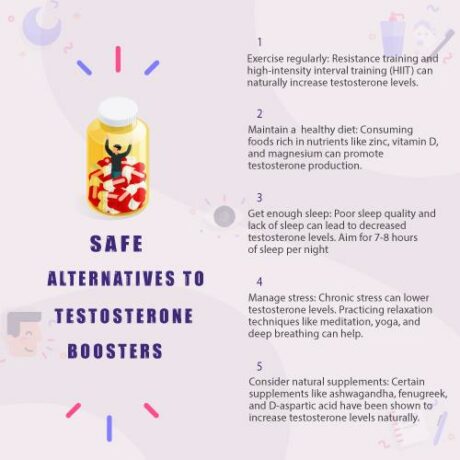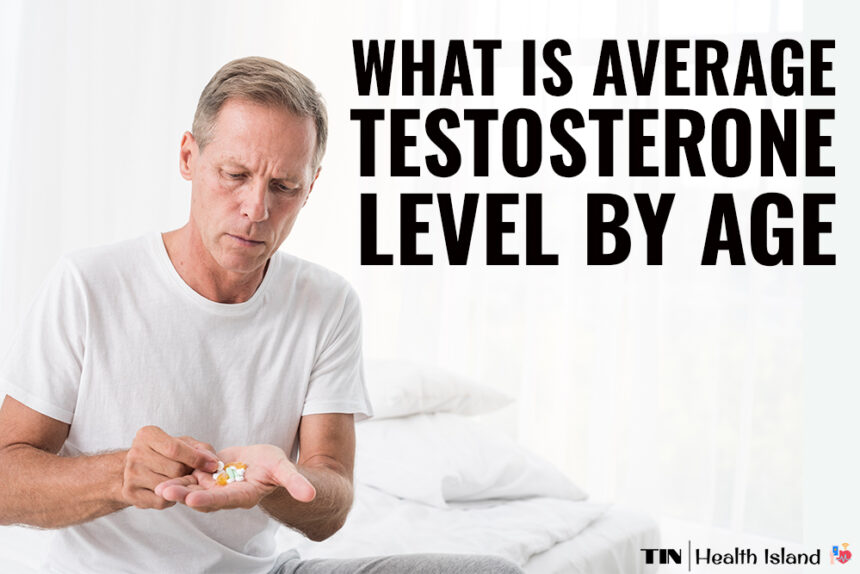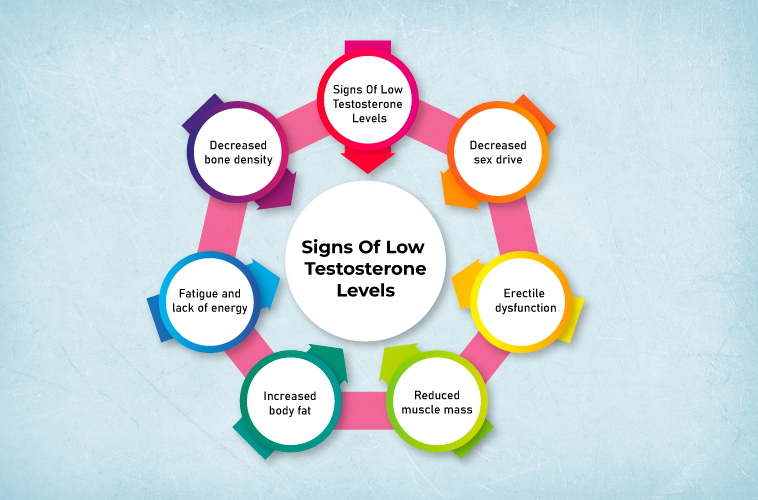All humans have testosterone, an essential hormone for regular bodily functions. Understanding the average testosterone levels by age is crucial to gauge hormonal health.
With that said, when it comes to testosterone, no one-size-fits-all rule can determine the average testosterone levels. An individual’s testosterone level depends on various factors, including overall health, medical condition, weight, sex, and age.
In general, males have higher testosterone levels compared to females. In addition, testosterone levels rise and fall in everyone naturally.
This brings the question, what are the normal testosterone levels by age? In this post, we’ve jotted down everything you should know about testosterone levels needed to stay healthy.
What Is Testosterone?
Testosterone is a hormone men produce in their testicles that plays a crucial role in sexual development, physical appearance, and muscle mass. While naturally high testosterone levels are rare, testosterone production is common to decrease as men age.
Therefore, there is no such thing as fixed testosterone levels. Though it is the male hormone, females also require certain testosterone levels for bodily function.
In males, these hormone levels are necessary for strengthening bones, muscle mass production, development during puberty, heart health, and cognitive functions.
In females, ovaries produce testosterone. The hormone is needed for fertility and sex drive, making new blood cells, muscle mass, heart health, and cognitive functions.
What are Normal Testosterone Levels by Age?
The average testosterone level in the blood of both men and women depends on protein status, thyroid function, and various other factors. These levels are measured in nanograms per deciliter (ng/dL).
The American Urological Association (AUA) states that at least 300 nanograms per deciliter (ng/dL) of testosterone levels in men is considered normal. Any level lower than this is considered testosterone deficiency.
According to Mayo Clinic Laboratories, for a woman older than 19, the healthy testosterone level lies between 8 and 60 ng/dL.
The testosterone levels are at their peak during the teenage years until the age of 18 and 19, and they start declining gradually. However, natural testosterone production in the human body starts as early as infancy and helps develop the male reproductive system.
Following is a breakdown of the normal testosterone levels by age:
In The Womb
The need for testosterone starts when the baby is in the womb. A normal testosterone level is needed for proper fetal development and the normal development of the male reproductive system.
Testosterone levels should also be healthy for the fetal brain to function normally. Another study states that a higher level of testosterone might cause autism.
How masculine you appear is also linked to how much testosterone was in the womb before birth.
One study found that higher testosterone levels in the womb are linked to more masculine features. In short, testosterone levels can affect how masculine or feminine you will look in the future.
Pregnant women tend to have higher natural testosterone levels than non-pregnant women. In non-pregnant women, the levels are below 50 ng/dL, but during pregnancy, the level lies between 50 and 120 ng/dL.
However, this is not a fixed level and may vary from person to person. These levels are highest in the third trimester, and they play a role in maintaining pregnancy and, in the end, help during labor.
Children and Early Teens
During the initial months after birth, the normal testosterone level in a male should be 75 to 400 ng/dL. This level continues to change. When a boy is around ten to eleven, the level changes to 7 to 130 ng/dL.
During the early teens, this level rises, and the normal level is between 7 to 800 ng/dL. However, when a boy is 15 or 16, the normal testosterone level should be between 100 to 1200 ng/dL.
The production of testosterone in the body affects the physical changes in boys during their teenage years. For instance, it will affect various physical features in the body during the puberty stage.
A boy’s facial structure changes to become more masculine, their voice will change (deeper voice), and shoulders will broaden.
During the late teens, between 17 to 19 years, the testosterone levels are between 300 and 1200 ng/dL. This is when testosterone levels peak and remain high for the next couple of years. A healthy young man produces around 6 mg of testosterone daily.
Adults
During early adulthood, from 20 to 30, healthy testosterone levels are 692 ng/dL on average. The normal range in adult males is between 376 and 1008 ng/dL.
However, as men age, their testosterone levels start declining gradually, that is, by 1% every year after age 30. On the contrary, in women, these levels decline after menopause, 45 or 50.
The testosterone levels by age keep declining in men; it decreases to 252 to 916 ng/dL during the 40s and 50s. During the sixties, testosterone levels decrease, and men produce 196 to 859 ng/dL of testosterone.
By the time a man is 70, the production of testosterone levels decreases to 30% below the peak level making it 156 to 819 ng/dL. However, this doesn’t mean that health also declines. Older men may have lower testosterone levels than young men, but it doesn’t affect them much if they take care of their health and are physically fit.
What Are The Signs Of Low Testosterone Levels By Age?
In the above section, we explained the normal age testosterone levels. If testosterone production is between these ranges, a man will remain healthy and not experience any issues.
However, for men with lower testosterone than the normal range, it might affect their sex drive, overall health, and wellness. For instance, it can cause weight gain, fatigue, and depression if testosterone levels decline.
You can also have low testosterone if any disease has caused damage to your testicles or ovaries, which produce the hormone. There are other medical conditions like male hypogonadism which also contribute to low testosterone levels.
Read More
Low-T can cause health conditions, including sexual issues. The following are the main signs of low testosterone levels:
- Low libido or low sexual desire
- Erectile dysfunction
- Impotence and Infertility
- Low energy
- Fatigue and depression
- Large breasts in men
- Loss of facial and body hair
- Weak bones and decrease in muscle mass
- Anxiety and lack of focus
- Fewer spontaneous erections
Other symptoms of low testosterone levels include:
- Changes in sleep patterns
- Difficulty concentrating
- You can gain weight
- Lack of motivation
- Reduced muscle bulk and strength
- Decreased bone density
If you are experiencing symptoms, you must consult your healthcare provider, who’ll recommend a test. This testosterone levels test determines the range of testosterone in your blood to further diagnose a condition or help you choose the right treatment.
Why Do Average Testosterone Levels By Age Decline?
Testosterone levels change with age due to a natural process similar to menopause in women called andropause. As men age, the organs responsible for hormone production slow down, decreasing testosterone levels.
However, optimizing hormone levels using testosterone boosters for conditions like erectile dysfunction and alleviating negative symptoms through appropriate measures is possible.
Effects of Low Testosterone
A lack of testosterone during fetal development can impact the growth and development of male fetuses and influence puberty. Hormone levels change as individuals age, with females experiencing more pronounced hormonal shifts until they reach menopause, while males gradually decline hormone levels.
Naturally, testosterone levels decrease with age in both males and females. Understanding these hormonal changes is important for overall health and well-being.
Read More
Decreased levels of testosterone in males can result in the following:
- Hair loss
- Loss of muscle tone
- Fragile skin
- Decreased libido
- Mood changes
- Impaired memory and concentration
Decreased levels of testosterone in females can cause:
- Irregular or absent menstrual periods
- Decreased libido
- Dryness of the vaginal area
- Reduced bone density, potentially leading to osteoporosis
- Challenges with fertility
Effects of High Testosterone Levels
Excess testosterone in the body are uncommon in adult males, although children with high levels may experience early puberty or a growth spurt. Similarly, too much testosterone in all genders can result in infertility, obesity, and potential metabolic disorders.
Polycystic Ovary Syndrome (PCOS)
PCOS primarily affects females and arises when the ovaries produce excessive testosterone. Symptoms include irregular or absent periods, oily skin, acne, and increased hair growth on the face, back, or chest.
The exact cause of PCOS is not fully understood, but a combination of genetic and environmental factors is believed to play a role.
Steroid Use
Anabolic steroids resemble testosterone and sometimes enhance muscle growth or weight gain. However, their usage can disrupt natural testosterone levels in both males and females.
Excessive steroid use can lead to elevated testosterone levels, decreased sperm production in males, infertility, and loss of libido. Females may experience a deeper voice, hair loss, irregular periods, and infertility.
Individuals of all genders may also encounter symptoms such as facial and body hair growth, oily skin, and other manifestations due to elevated testosterone levels.
Blood Test and Diagnosis
If an individual suspects imbalances in their testosterone levels, it is crucial to consult a healthcare professional or undergo testing for an accurate diagnosis.
To diagnose low or high testosterone, a doctor will typically inquire about the person’s medical history, conduct a physical examination, and order specific tests.
In males, the doctor may discuss steroid or opiate use, assess puberty development, measure body mass index and waist size, examine hair for pattern baldness, and check the size of the testicles and prostate gland.
In females, healthcare professionals may inquire about menstruation, acne or skin conditions, body or facial hair, and muscle bulk.
For adolescents, doctors will observe signs of puberty.
The total testosterone level test, conducted via a blood test, is commonly used. Morning testing is recommended as testosterone levels are usually highest at that time hence, helping measure testosterone. However, variations throughout the day may require retesting for confirmation of results.
A healthcare professional is advised for proper evaluation and interpretation of the tests.
Treatment Options
Testosterone replacement therapy is an effective method for managing low testosterone levels and relieving associated symptoms. It is available in various forms, such as oral medications, injections, gels, patches, and pellets. There are certain medications which are also considered a form of treatment.
These methods deliver testosterone to the body to maintain optimal levels. The therapy’s duration can be short-term or long-term, depending on individual needs and conditions.
Read More
However, it is important to note that testosterone replacement therapy may not be suitable for individuals with certain health conditions, such as heart disease, breast or prostate cancer, sleep apnea, or increased red blood cells. Consultation with a doctor is essential before starting any testosterone therapy.
In addition to medical interventions, natural approaches to increasing testosterone levels include adopting a healthy lifestyle. Regular exercise, weight management, stress reduction, adequate sleep, and a balanced diet promote hormonal balance.
Lifestyle factors, such as avoiding sedentary habits and following a nutritious diet, can positively impact testosterone levels. Consulting with a healthcare professional can guide the most suitable treatment options and lifestyle modifications.
Potential Risks of Testosterone Replacement Therapy
Although Testosterone Replacement Therapy (TRT) benefits many men with testosterone concerns, it may not suit everyone, particularly those with pre-existing health conditions.
Individuals with specific types of cancer, such as prostate cancer and severe kidney, heart, or liver problems, should consider alternative testosterone treatments. Men with testosterone issues must consult a medical professional specializing in hormone replacement therapy to determine the appropriate medications.
Seeking guidance from a healthcare provider experienced in TRT is highly recommended to assess individual suitability and ensure safe and effective treatment options are pursued.
How Often Should You Test Your Testosterone?
According to doctors, you should have the test when you reach the age of 35. After that, you can have these levels checked every 2-3 years. The levels vary widely during different stages of life, but most testosterone ranges are according to the levels we discussed according to age group.
The testosterone levels in men can be controlled through therapies and precautions. The male body needs a balance of testosterone to function normally.
Natural Ways to Boost Testosterone Levels
There are natural approaches to increasing testosterone levels that can complement medical treatments like testosterone replacement therapy.
Engage in Regular Exercise
Regular exercise can prevent testosterone loss and potentially elevate levels. Studies show that individuals who exercise regularly have higher testosterone levels compared to those with a sedentary lifestyle. Weight lifting, in particular, is recommended for boosting testosterone and managing weight gain.
Make Dietary Changes
Losing excess body fat can positively impact testosterone levels in adult males. If you have low testosterone, adjusting your diet to promote weight loss is beneficial. Increasing protein intake is advised, and combining it with high-resistance training may warrant incorporating more carbohydrates. Such lifestyle changes can contribute to a better overall health.
Reduce Stress Levels
Elevated stress can lead to increased cortisol levels, which can subsequently lower testosterone. Managing stress through adequate sleep and adopting a balanced lifestyle is crucial. Additionally, spending time outdoors in the sunlight can help boost vitamin D, which supports testosterone production.
By implementing these natural strategies, you can potentially optimize your testosterone levels and support your overall well-being.

Conclusion: What Is Ideal Level Of Testosterone?
The level of testosterone declines as you age. Your level at 19 will be different from what you have at 58. This doesn’t mean you should panic; you just must observe the signs and symptoms. There are legitimate t-boosters such as TestoPrime which help with boosting testosterone levels.
The decrease in this level is very gradual, and many people might not even notice the effects. The effects are prominent only when there are sudden changes in the levels. You can increase your testosterone levels by eating testosterone boosting foods in natural ways.
If you are concerned about low or high testosterone, you must talk to your doctor and discuss the best




